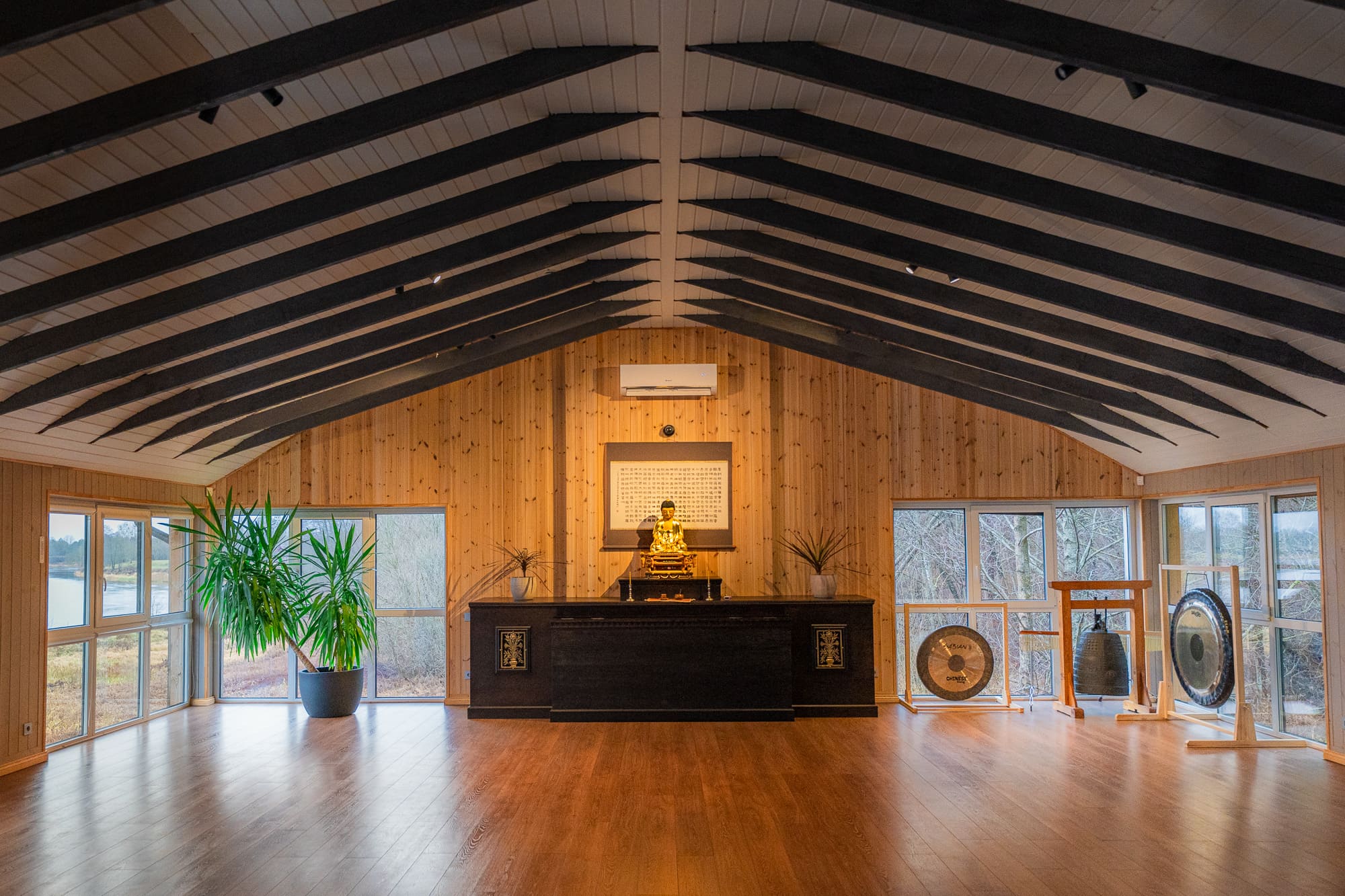Spain’s idyllic Mediterranean coastline needs no introduction, but there’s more than one way to spend a beach day. Avoid the crowds by heading inland, where dozens of stunning lakes await. From the shores of Lagunas de Ruidera to the famously pink waters of Salinas de Torrevieja, you can cover miles of Spanish countryside and still have time for a swim. All four corners of the country—northern, southern, eastern, and western—have their own jewels to explore.
Northern Spain
The culture of Northern Spain reflects a melting pot of Basque and Celtic heritage. Here, you’ll find five-star restaurants in small mountain towns, beach cities with thriving arts scenes, and history coming to life all around you.
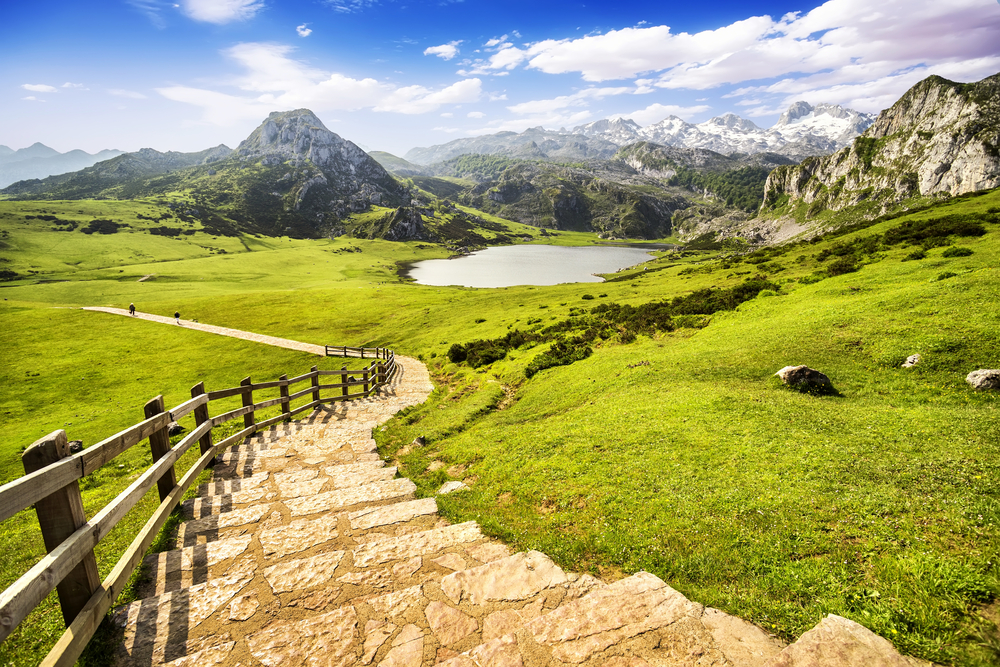
Lakes of Covadonga | Cangas de Onís, Asturia
Also known as the Lakes of Enol or simply Los Lagos, the two glacial Lakes of Covadonga are nestled in the Picos de Europa National Park. Several hiking trails wind around the lush shores of Lake Enol and Lake Ercina, but no matter which route you take, make sure to snap some pics at the Mirador de Entrelagos vista.
After the lakes, visit the nearby Covadonga Sanctuary for a moment of quiet reflection. This small stone chapel, perched in a rocky cave above green waters, is worth a stop both for its beauty and historical significance. For more Spanish history and architecture, book a stay just an hour away at Hotel Castillo del Bosque la Zoreda, one of Spain’s many castle hotels.

Ibones de Anayet | Sallent de Gállego, Huesca
Deep in the Pyrenees, two volcanic peaks tower over the Ibones de Anayet, a series of small, isolated lakes. Reaching the lakes requires an uphill trek of several hours, but hikers who make the trip will be rewarded with breathtaking views of the surrounding mountains.
Naturally, summer is the best time to visit. During winter, however, you can ski or ride a snowcat to La Glera, which serves an exclusive, multi-course dinner menu finished off with a glass of G.H. Mumm champagne. For an extended stay, consider the Hotel Saliecho in the nearby ski village of Formigal and eat dinner at Casa Martón, a traditional Aragonese steakhouse in Sallent de Gállego.
Southern Spain
Andalusia, with its abundant vineyards, olive groves, and Moorish architecture, makes up the nation’s southern tip. Beachgoers often crowd the area’s 600-plus miles of Mediterranean coastline, but you can soak up the sunshine lounging on these tranquil lake shores.
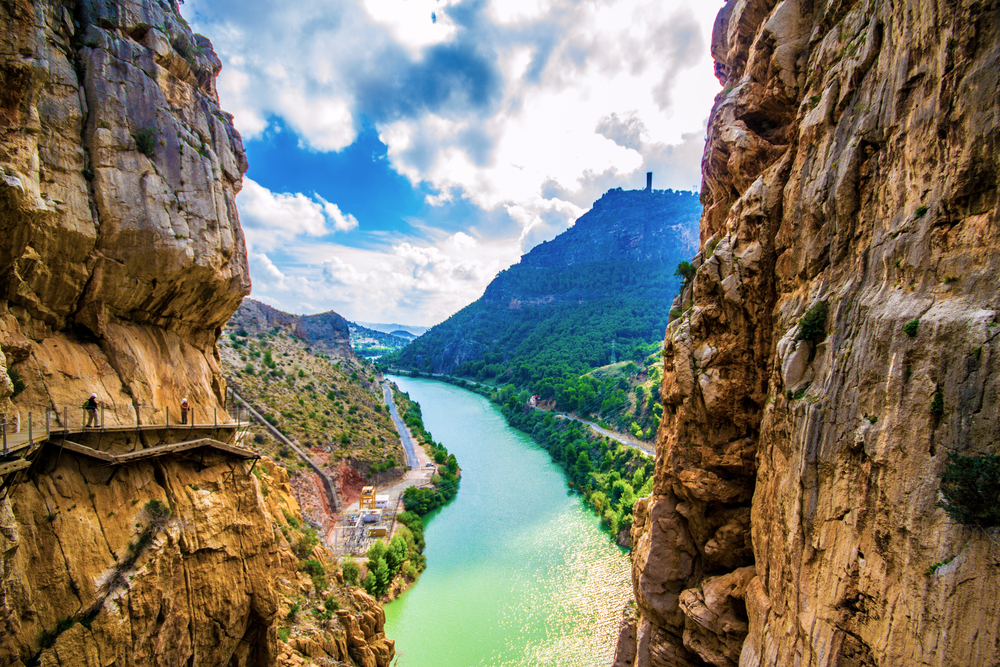
El Chorro Lakes | El Chorro, Málaga
The three El Chorro Lakes—Embalse Conde de Guadalhorce, Embalse del Guadalteba, and Embalse del Guadalhorce—draw all kinds of outdoor enthusiasts. Kayakers, bird watchers, and mountain bikers visit year-round, as well as tourists eager to hike the hanging cliff walkways of El Caminito del Rey, “The King’s Little Path.” Purchase tickets in advance.
Those seeking a more relaxing experience can easily find secluded spots to sunbathe or swim in the reservoirs’ turquoise waters. If you get too warm, retreat to the lakeside La Garganta restaurant and hotel to cool off.
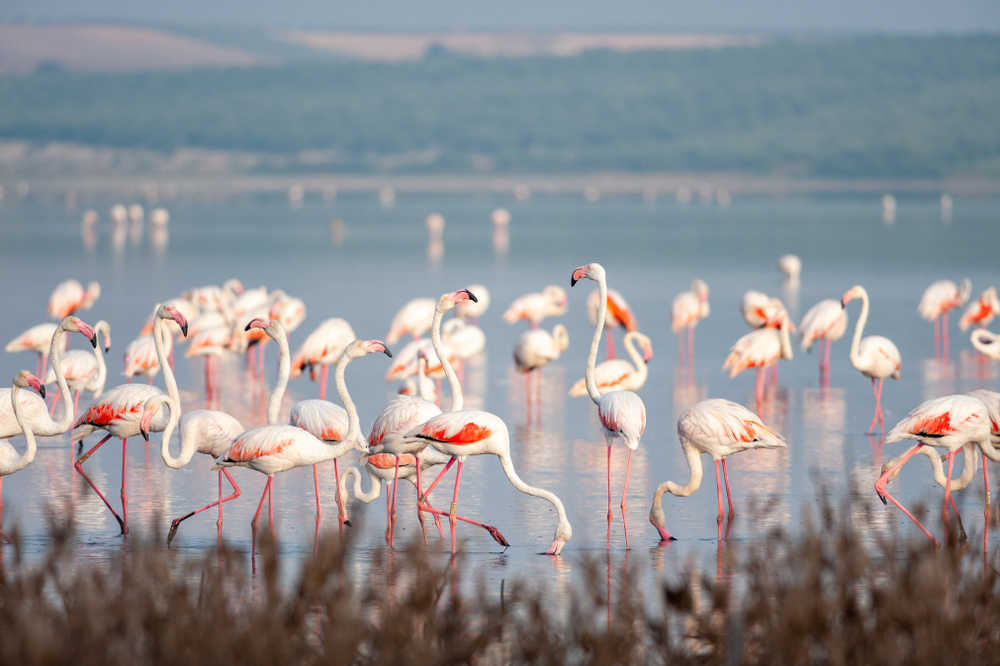
Laguna Fuente de Piedra | Fuente de Piedra, Málaga
The Laguna Fuente de Piedra boasts a unique ecology and history. This saltwater laguna only exists during wet months, drying up into a salt flat at other times. Swimmers may be disappointed by the low waters even in the wet season, but with luck and good timing, bird watchers might glimpse flamingos, sandpipers, gulls, and storks.
During the wet season, a colony of flamingos arrives to breed in the shallow waters. The lake has also provided an invaluable salt source for human inhabitants since Roman times. To fully immerse yourself in the history of Málaga’s famous lake district, spend a night or two at Hotel Convento de la Magdalena, half an hour from Laguna Fuente de Piedra.

Embalse de Los Bermejales | Arenas del Rey, Granada
You can swim, sail, or canoe across the placid waters of this enormous reservoir in Granada. Completed in 1958, the Embalse de Los Bermejales is tucked away in a quiet corner of the province, not far from more touristy areas.
Start your trip by picking up lunch to-go from Picnic Gourmet in the city of Granada, then drive 45 minutes to the tiny but quaint town of Arenas del Rey. Stake out a picnic table on the shore, where you can spend the rest of your day snacking on Iberian ham, dipping in the water, and napping in the shade.
Eastern Spain
Much like Southern Spain, Eastern Spain is another favored destination for its beaches, which border the Mediterranean’s vibrant blue waters. This region is home to metropolises like Barcelona and Valencia, as well as one of Spain’s most renowned delicacies: paella.

Lake Banyoles | Banyoles, Girona
Calling all anglers—you won’t want to miss the Lake of Banyoles. Sunfish, eel, black bass, catfish, and more swim in the freshwater lake. Make sure to get an early morning start, or charter a fishing tour with Captain Experiences to gain local expertise.
The lake is equally fun for those not planning to fish, with boat rentals available in the neighboring towns of Porqueres and Banyoles. Closer to land, you can swim on the public beaches and rest shoreside with an artisan, cream-filled xuixo from Fleca Patisseria. When the sun goes down, catch a stellar view at the Mil Estrelles hotel in Banyoles, made up of innovative “bubbles” that allow you to see the starry skies from the comfort of your bed.

Las Salinas De Torrevieja | Torrevieja, Alicante
Similar to Salins d’Aigues-Mortes in France, Spain’s pink salt lake attracts visitors from all over the world. Near the Costa Blanca, Las Salinas de Torrevieja nature park includes Laguna Salada de la Mata and the famous Laguna Rosa. This large lake gets its pink color (and distinctive smell) from microorganisms in the water.
Besides being a great destination for photography, the shores of Laguna Rosa host dozens of bird species, including flamingos. While you can technically swim in the water, the lakes’ scent and high salt content might keep some on land. There, you can take a guided walking or bicycle tour on weekends.

Estany de Sant Maurici | Espot, Lleida
Catalonia’s only national park, Aigüestortes i Estany de Sant Maurici, can be found in the Pyrenees. Beneath Encantats peak, the remote Estany de Sant Maurici lake has incredible opportunities to see wildlife, with miles of hiking trails through alpine meadows dotted with wildflowers.
Espot has a solid handful of highly rated dining options despite a population of less than 500 people. After a long day of hiking, enjoy innovative Mediterranean offerings at Restaurant La Llupia, or tapas on the terrace of La Mossada.
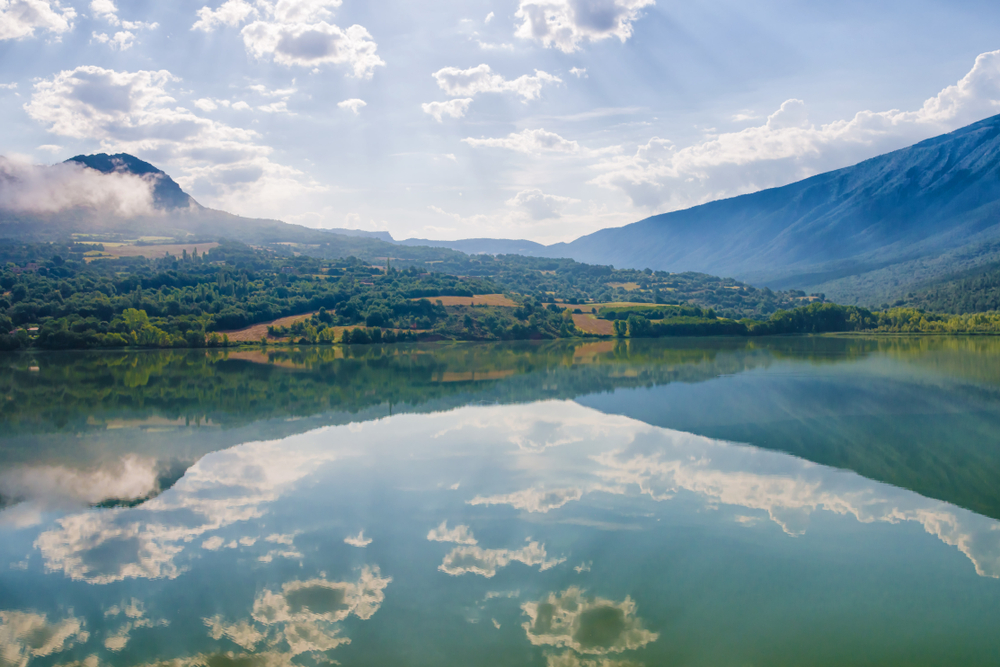
Embalse de los Terradets | Cellers, Lleida
Surrounded by soaring mountains, the Embalse de los Terradets is a scenic destination for water sports like kayaking and swimming, as well as tranquil views from the banks. Here, you can see historic tunnels with balconies overlooking the water, the impressive Terradets dam, and numerous bird species in the northern wetlands.
Visitors can drive or ride the train to the small, shoreside town of Cellers. From there, go straight to the water—or to the Hotel Terradets, where you can eat lunch above the reservoir at Del Llac Restaurant before checking into a lakeside room.

Martel Lake | Manacor, Balearic Islands
While most visit the island of Mallorca for its bustling nightlife and sunny beaches, an entirely different type of experience takes place at Martel Lake—25 meters below ground.
Europe’s largest underground lake spans 117 meters through the four Cuevas del Drach, a natural wonder beneath the town of Manacor. Tours begin on foot, as visitors descend far below some of the most picturesque limestone cliffs in Spain. After marveling at all the sights, take a seat for a 10-minute classical music concert on Martel Lake before boarding a rowboat and returning to the surface.
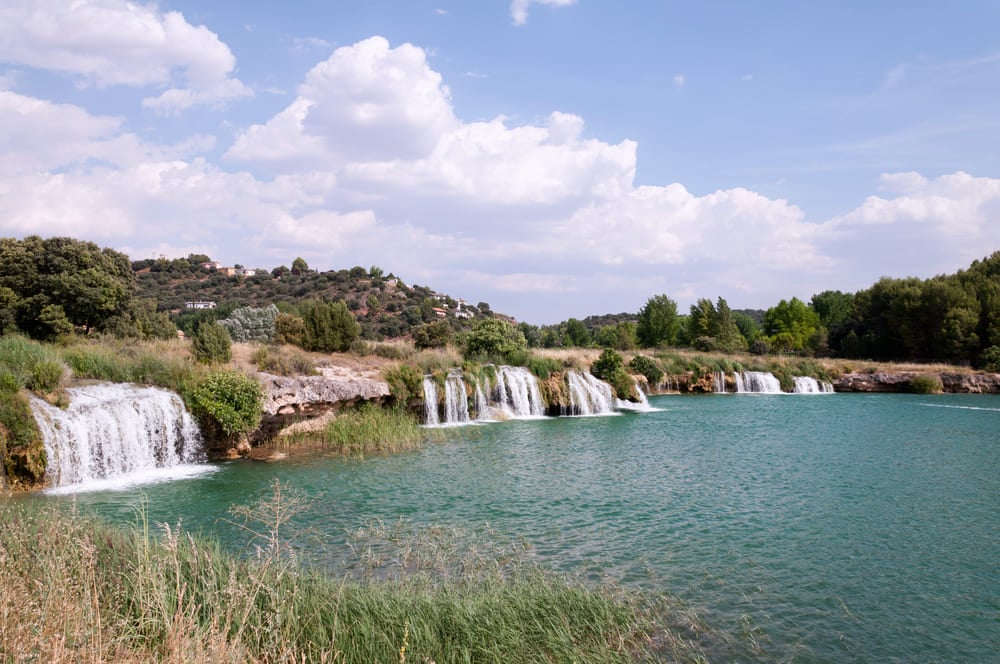
Lagunas de Ruidera | Ruidera, Ciudad Real
Comprising a small chain of lakes and lagoons in Castilla-la Mancha, Lagunas de Ruidera is one of Spain’s most popular areas for outdoor recreation. You can boat or bird-watch along the 15 lagunas, but make sure to carve out some time for the karst (calcium carbonate) formations. Swim through glowing green waters in a cave on Laguna Colgada, or let a waterfall wash over you at Laguna del Rey.
Western Spain
Made up of three culturally diverse autonomous regions—Extremadura, Castile and León, and Galicia—Western Spain is full of UNESCO World Heritage Sites, some of Spain’s most rugged beauty, and food as varied as the landscapes.

Embalse de Riaño | Riaño, León
Located in northeast León, the sprawling reservoir of Embalse de Riaño, or Remolina, is surrounded by alpine peaks. Visitors can view the water via a network of hiking trails, which wind through the regional park on the lake’s shores. Fully explore the nooks and crannies of the “Leonese fjords” on a boat tour with Riaño en Barco.
On land, you can wind down with a meal at the Restaurante El Mesón, frequented by locals and tourists alike. With any extra time, stop by the Museo Etnográfico to see how Riaño’s inhabitants once lived.

Lake Sanabria | Puebla de Sanabria, Zamora
Spain’s largest freshwater glacial lake, Lake Sanabria, has a surface area of more than one square mile for visitors to enjoy dozens of outdoor activities.
While the lake is far from the coast, you can still bask on the sandy beaches of Custa Llago and Playa Viquiella. Rent a kayak or a pedal boat with a built-in slide from Verdeagua, stop by the information center to learn about native wildlife like the endangered Iberian wolf, take an environmental cruise, or hike around the lake’s shores on one of the many trails.
Stay or dine near the lake at Villa Lucerne, which caters to sports enthusiasts seeking a luxurious getaway, or 20 minutes away at Hotel Treixas, located in the historic-artistic town of Puebla de Sanabria.

Laguna Negra | Vinuesa, Soria
Laguna Negra’s beauty runs as deep as its legends. Found in the majestic Picos de Urbión mountain range of Soria, this high-altitude, glacial lagoon was once believed to be bottomless and named as such. While other rumors surround the lake in mystery (and have fascinated poets for centuries), the spectacular views are in plain sight.
The lake is best experienced as a day trip, especially to take on the summit of Pico Urbión in an 8-mile loop. While several home base locations are closer to the lake, consider a stay 1.5 hours away in Rioja country outside Lagroño, where Michelin-starred Venta Moncalvillo and the winery, hotel, and spa Finca de los Arandinos await.



